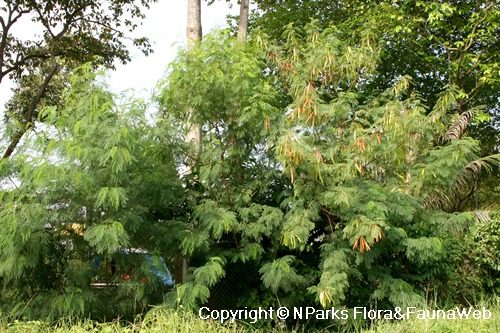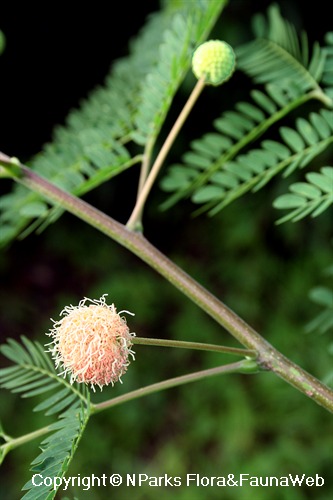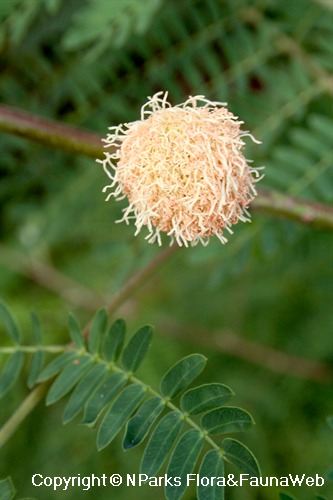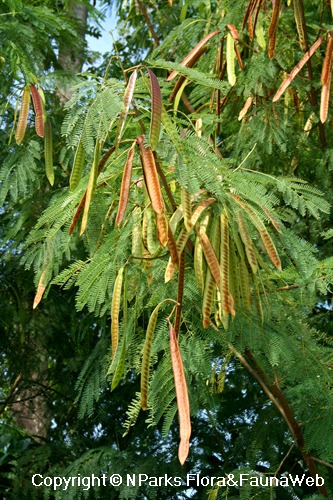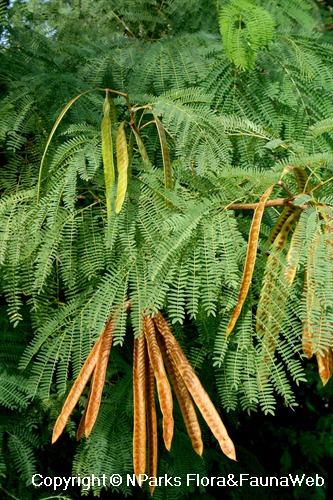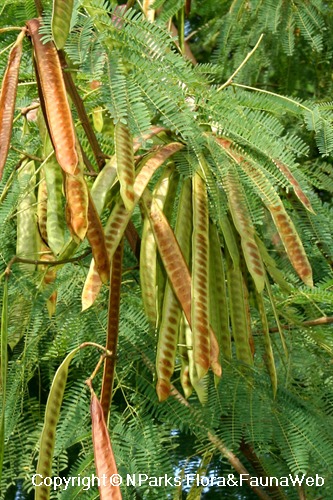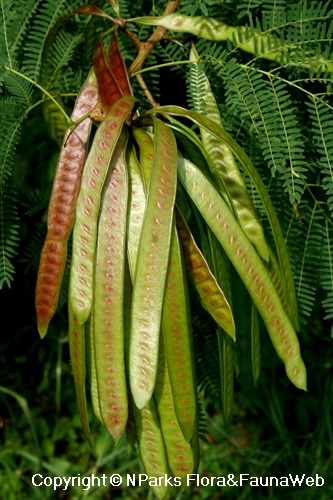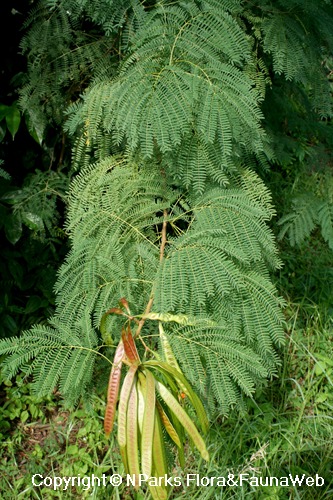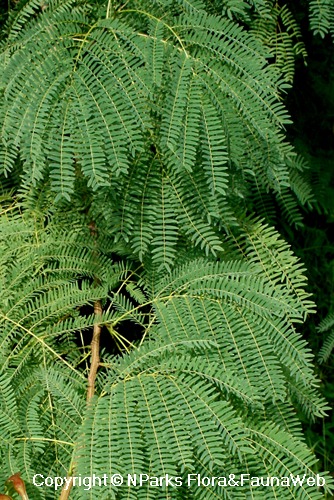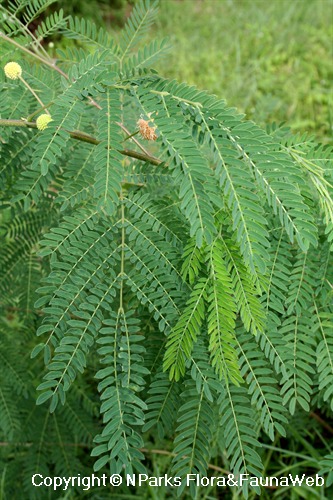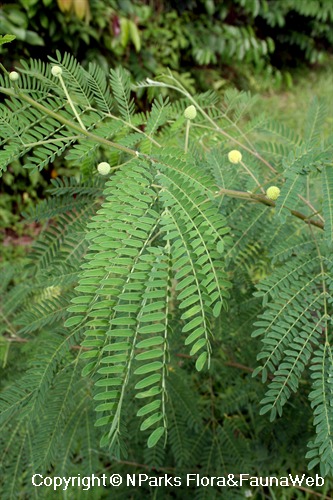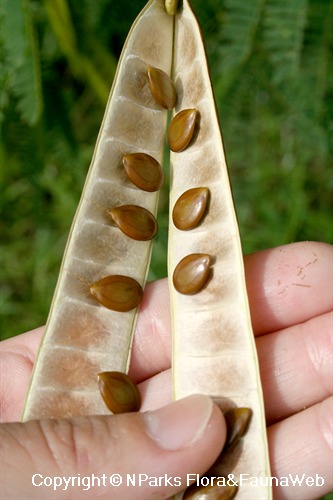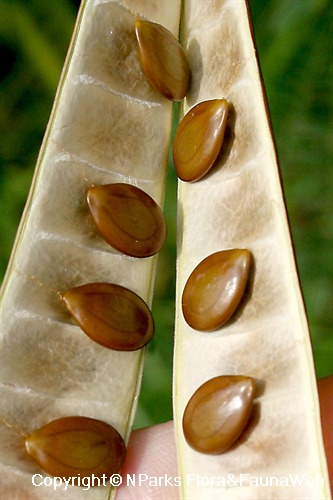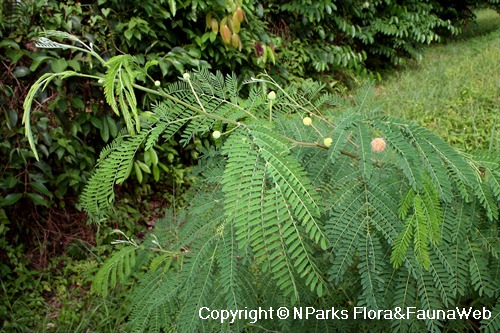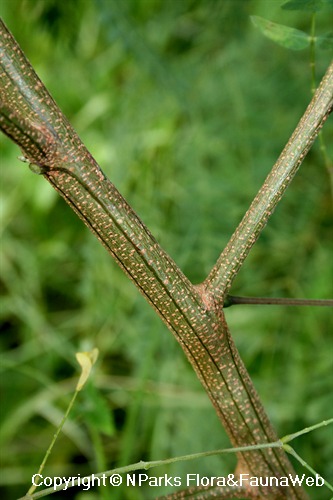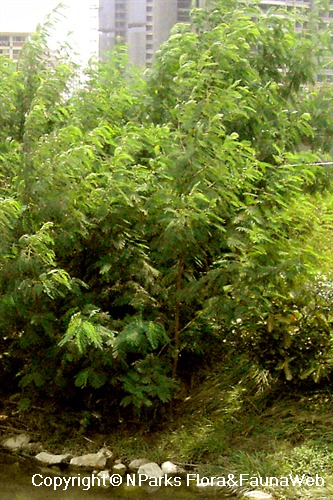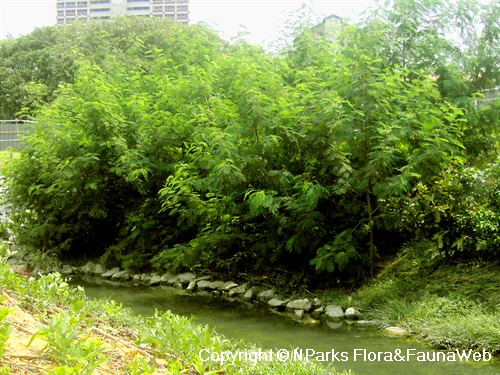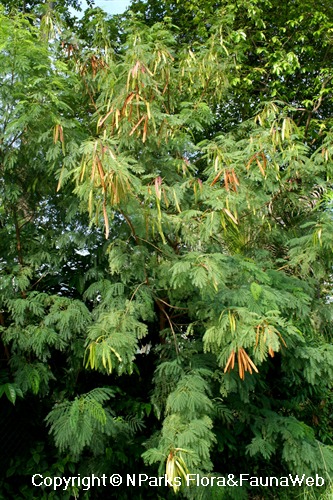
Back
Leucaena leucocephala (Lam.) de Wit
| Family Name: | Fabaceae (Leguminosae) |
| Synonyms: | Acacia glauca, Leucaena latisiliqua, Mimosa leucocephala, Leucaena glabrata, Leucaena glauca |
| Common Name: | Lead Tree, Reuse Wattel, White Popinac, Horse Tamarind, Wild Tamarind, Leucaena, Jumbie Bean, Jumbay, Ipil-ipil, Petai Jawa, 银合欢, 臭豆 |
Name
Classifications and Characteristics
| Plant Division | Angiosperms (Flowering Seed Plants) (Dicotyledon) |
|---|---|
| Plant Growth Form | Tree (Small (6m-15m), Shrubby (1m-5m)), Shrub |
| Lifespan (in Singapore) | Perennial |
| Mode of Nutrition | Autotrophic |
| Plant Shape | Shrubby |
| Maximum Height | 2 m to 6 m |
Biogeography
| Native Distribution | Mexico, Belize, Guatemala |
|---|---|
| Native Habitat | Terrestrial (Secondary Rainforest, Coastal Forest, Riverine, Grassland / Savannah/ Scrubland, Disturbed Area / Open Ground) |
| Preferred Climate Zone | Tropical |
| Local Conservation Status | Non-native (Spontaneous (Naturalised)) |
Description and Ethnobotany
| Growth Form | Large leguminous thornless shrub or small scrubby tree, forming dense stands with bushy crowns up to 6m height. Relatively short-lived, with lifespan of 20-40 years. |
|---|---|
| Trunk | Bark greyish with prominent lenticels. |
| Foliage | Bipinnately-compound leaves with small grey-green leaflets, pungent when crushed. |
| Flowers | White and filamentous, produced in dense globular heads (1-2 cm across), resembling those of Mimosa. |
| Fruit | Explosive capsules, flat and thin, up to 20cm long by 2cm wide, ripening from green to brown, each containing 15-25 shiny brown seeds. |
| Habitat | Found in disturbed and degraded sites like scrubland and grassland, limestone areas, along rivers and coasts, as well as within agricultural land. |
| Cultivation | Hardy species with deep root system, drought-tolerant when established. Prefers deep fertile clay soils, but fixes its own nitrogen and tolerant of poor soils with high aluminum and low iron and phosphorus content. Performs poorly in acidic soils, unless supplemented with calcium, sulphur and molybedum minerals. Performs best in pH-neutral to alkaline soils. May need to be pruned regularly to control size and spread. Susceptible to infestation by Heteropsylla cubana psyllids - small aphid-like sucking insect-pests, which tend to create severe outbreaks at beginning and end of rainy seasons. Easily propagated by seeds -- before sowing, scarify hard waxy testa (seed coat) or place seeds in boiling water for 48 hours / until they absortb water; or use cuttings, which root easily. |
| Etymology | Genus epithet 'Leucaena' derived from Greek 'leukos' (white), a reference to the white inflorescences of the plant. Species epithet 'leucocephalus' means 'white-headed', again alluding to the flower inflorescences. |
| Ethnobotanical Uses | Edible Plant Parts : Edible Fruits, Edible Leaves, Edible Seeds Food (Fruit or Vegetable) (Herb or Spice) Others: Medicinal: Leaf paste applied to poisonous stings and bites in Myanmar. Seeds used to treat diabetes and expel intestinal worms. Roasted seeds used as emollient and to increase menstrual flow. Decoction of bark and roots used as contraceptive or for inducing abortion in Latin America. Food: Young leaves and seedpods high in protein and Vitamin A, eaten as vegetable. Seeds used as bean substitute in tempeh (traditional bean cake), reported to be delicious. Seeds also used as coffee bean substitute. Ripe seeds sometimes eaten parched like popcorn. However, plant contains mimosine, a dilapitory amino acid that is toxic to non-ruminant vetebrates when consumed in excess -- known to cause hair loss from manes and tails of horses. Heating leaves or adding iron sulphate salts reportedly degrades the mimosine or reduces its toxicity. Products: Wood used as firewood and charcoal. Also used to make small objects like fish-traps. Bark yields a brown dye. Exuded gum used in Asia as replacement for gum arabic. Seeds used as beads on bags or strung into necklaces in tourist trade in West Indies. Agronomy: Used as cover crop and green manure/ mulch in plantations to improve nitrogen content in soils. Also used as easily-digestible fodder for livestock (esp. cattle), although it has toxic effects on non-ruminants. |
Landscaping Features
| Desirable Plant Features | Ornamental Foliage, Ornamental Flowers, Ornamental Fruits, Ornamental Seeds |
|---|---|
| Landscape Uses | Coastal, General, Phytoremediation |
| Thematic Landscaping | Economic Garden, Naturalistic Garden |
| Usage Hazard - Cons | Invasive / Potentially Invasive, Low Crown / Clearance |
| Plant & Rootzone Preference or Tolerance Remarks | pH 5.5 - 8.5 |
Fauna, Pollination and Dispersal
| Fauna Pollination Dispersal Associated Fauna | Bird-Attracting |
|---|---|
| Pollination Method(s) | Biotic (Fauna) (Insects (Bee), Insects (Butterfly, Moth), Insects (Ant, Beetle, Fly, Thrip, Wasp)) |
| Seed or Spore Dispersal | Abiotic (Explosive Dehiscence) |
Plant Care and Propagation
| Light Preference | Full Sun |
|---|---|
| Water Preference | Moderate Water, Little Water |
| Plant Growth Rate | Fast |
| Rootzone Tolerance | Drought Tolerant, Fertile Loamy Soils, Well-Drained Soils, Poor Infertile Soils, Saline Soils / Salt Spray, Alkaline high pH Soils |
| Maintenance Requirements | Moderate |
| Diseases | Main insect pest is the psyllid Heteropsylla cubana -- a small aphid-like sucking insect that causes periodic periodic outbreaks, esp. at at start and end of wet season in tropics. |
| Propagation Method | Seed, Stem Cutting |
Foliar
| Foliage Retention | Evergreen |
|---|---|
| Mature Foliage Colour(s) | Green |
| Mature Foliage Texture(s) | Smooth, Thin |
| Foliar Type | Compound (Even-Pinnate) |
| Foliar Venation | Pinnate / Net |
| Foliar Margin | Entire |
| Leaf Area Index (LAI) for Green Plot Ratio | 4.0 (Tree - Dense Canopy) |
Non - Foliar and Storage
| Trunk Type (Non Palm) | Woody |
|---|---|
| Mature Bark Texture | Lenticellate |
| Stem Type & Modification | Woody |
| Root Type | Underground (Tap Root, Fibrous Root) |
Floral (Angiosperm)
| Flower & Plant Sexuality | Bisexual Flowers |
| Flower Colour(s) | White |
|---|---|
| Inflorescence Type | Head / Capitulum |
| Flowering Period | Free-Flowering |
| Flowering Habit | Polycarpic |
| Inflorescence Size Remarks | White to pinkish |
Fruit, Seed and Spore
| Mature Fruit Colour(s) | Brown |
|---|---|
| Fruit Classification | Simple Fruit |
| Fruit Type | Dehiscent Dry Fruit , Legume / Pod |
References
| References | V. Sakthivel and M. Vivekanandan. . Physiology and Molecular Biology of Plants. 15. 2. 175-180 |
|---|
Image Repository
Others
| Master ID | 29162 |
|---|---|
| Species ID | 3471 |
| Flora Disclaimer | The information in this website has been compiled from reliable sources, such as reference works on medicinal plants. It is not a substitute for medical advice or treatment and NParks does not purport to provide any medical advice. Readers should always consult his/her physician before using or consuming a plant for medicinal purposes. |

